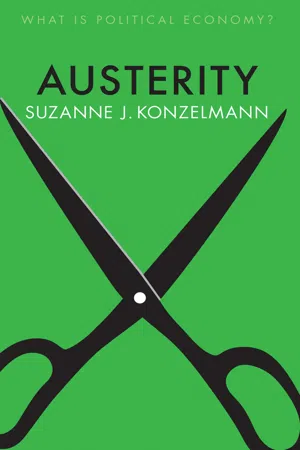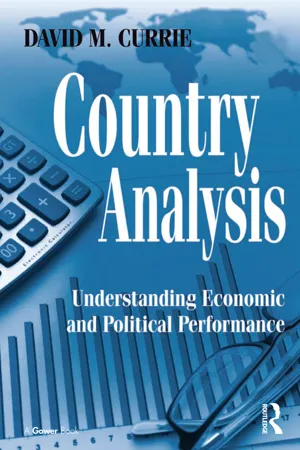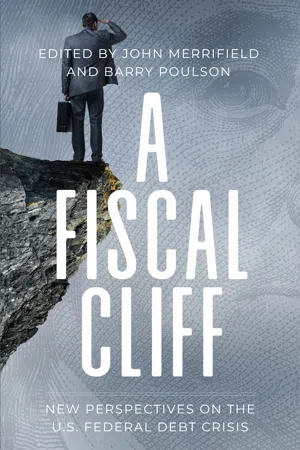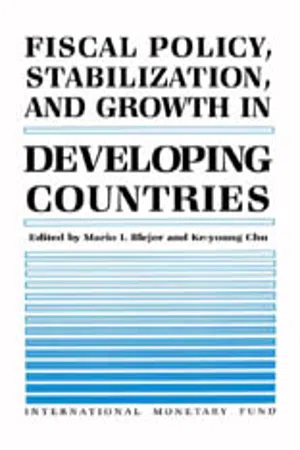Budget Deficit
A budget deficit occurs when a government's spending exceeds its revenue in a given period, typically a fiscal year. This shortfall is often financed through borrowing, which can lead to an increase in national debt. Budget deficits can result from various factors, including economic downturns, increased government spending, or reduced tax revenues.
8 Key excerpts on "Budget Deficit"
- eBook - ePub
- Anthony J. Makin(Author)
- 2016(Publication Date)
- Routledge(Publisher)
...Budgets are keenly anticipated by economists and media commentators as they reveal the government’s proposed fiscal stance and policy priorities. The fiscal number that attracts most attention is the overall budget balance. The budget balance is simply defined as the difference between total revenue and outlays and is either in deficit or surplus. Revenue raised by governments is mainly via taxation, but includes other forms, such as income from government corporations and government assets. On the other side of the budget, outlays are comprised of direct government expenditure, social welfare benefits, pensions and interest on public debt. In symbols, the basic budget relationship can be stated as where BB is the budget balance, T is total revenue, T r is transfers (which are effectively negative taxes) and G is direct government spending; BB is in deficit when outlays exceed revenue and in surplus when revenue exceeds outlays. As budgets have characteristically been in deficit over past decades, commentators use the size of the Budget Deficit measured in absolute terms, or expressed as a proportion of GDP, as an indicator of the fiscal stance. If, for instance, the UK budget predicted a lowering of the deficit from £15 billion to £10 billion next year, this might be interpreted as a measure of fiscal contraction. However, further adjustments should be made to official budget balance data to ascertain the true fiscal stance. First, nominal BB measures should be adjusted for the distortionary effect of domestic inflation as explained in Appendix A of this chapter. Inflation-adjusted measures of Budget Deficits may still be misleading, however, to the extent that the state of the economy itself may affect budget outcomes. This is because government revenue, especially income taxes as well as indirect taxes on goods and services, is procyclical. It rises and falls in line with domestic economic activity and the business cycle...
- eBook - ePub
- James Gosling, Marc Allen Eisner(Authors)
- 2015(Publication Date)
- Routledge(Publisher)
...A large economy that generates a high national income has more room to run deficits and incur debt than does a much smaller economy. A rapidly growing economy is better positioned to take on rising deficit and debt levels than is a static or declining economy. Deficits and debt that take a declining share of the GDP place a lessening burden on the economy’s ability to support them. Tables 5.1 and 5.3, respectively, show changes in the federal Budget Deficit and in debt held by the public as percentages of the GDP over time. Deficit levels following the 2007–2009 recession reached levels that exceeded those of the mid-1980s as a percentage of the GDP. The relative gap was even wider for publicly held debt as a percentage of the GDP, when comparing these two periods. Beyond viewing deficits and debt in relation to the size of the economy and its relative growth, several prominent economists suggest that we should rethink the way in which the deficit, and its contribution to debt, is measured. Robert Eisner, for example, argues that several adjustments should be made to the gross deficit. The first adjustment takes into account the surpluses or deficits of state and local governments. Because laws require nearly all state and local governments to balance their budgets, both tend to underestimate revenues and build some leeway into budgeted expenditures, commonly leading to year-end surpluses. State and local budget surpluses either can offset a federal Budget Deficit when that deficit exceeds their aggregate level or can contribute to a national budget surplus...
- eBook - ePub
Contemporary Economics
An Applications Approach
- Robert Carbaugh(Author)
- 2016(Publication Date)
- Routledge(Publisher)
...Conversely, counteracting inflation means decreasing government spending or increasing taxes, resulting in a budget surplus. From the viewpoint of economic stabilization, Budget Deficits and surpluses are a common feature of fiscal policy. The federal deficit (surplus) is the difference between total federal spending and revenue in a given year, as seen in Figure 13.3. To cover this gap, the government borrows from the public. Each yearly deficit adds to the amount of debt held by the public. Referring to the figure, we see that the federal government’s budget has generally been in deficit. Also, the term federal debt represents the cumulative amount of outstanding borrowing from the public over the nation’s history. It has been rising because of the persistent federal deficits that have occurred on an annual basis. Figure 13.3 Deficits and Surpluses of the U.S. Government under Various Presidents, 1981–2011 Source: Economic Report of the President, 2012, Table B–81. Table 13.4 Federal Debt Held by the Public Year Federal Debt Federal Debt as a Percent of GDP 1940 $43 44 1945 236 106 1955 227 57 1965 261 38 1975 395 25 1985 1,500 36 1995 3,603 49 2005 4,592 37 2014 12,780 73 Source: Economic Report of the President, 2015. The main measure of the U.S. federal debt is the debt held by the public. This is the measure most commonly used because it reflects how much of the nation’s wealth is absorbed by the federal government to finance its obligations and, thus, best represents the current impact of past federal borrowing on the economy. As seen in Table 13.4, the federal debt held by the public was $12,780 billion in 2014. In contrast, the federal debt was only $43 billion in 1940. The amount of a borrower’s debt by itself is not a particularly good indicator of the debt’s burden. If size were the only thing that mattered, a wealthy individual with a large mortgage would be judged to have a greater debt burden than a person of modest means with a smaller mortgage...
...We will also explore the fiscal multiplier because, while stimulus and austerity can influence the direction of change in the sectoral balances, the fiscal multiplier will have a significant effect on the size of that change. Fiscal Deficits and Public Debt Since there is no precise definition of what austerity actually is, it is unsurprising that significant confusion remains. Nor is it just the public that has a poor understanding of the concept; both politicians and the media frequently – and wrongly – use the terms “deficit” and “debt” interchangeably. In 2013, for example, Britain's then Prime Minister David Cameron was publicly rebuked by the UK Statistics Authority for claiming that, by reducing the fiscal deficit (rather than returning it to surplus), his government was “paying down Britain's debts.” At the time, the UK's national debt was in fact rising – which it would, for as long as the budget remained in deficit. We therefore need to start with what government deficits and public debt actually are, how they relate to each other and, eventually, the sectoral balances framework. A government's “primary fiscal deficit” (or surplus) is the difference between its annual expenditure and its revenues; its debt includes not only public debt that has been accumulated over previous years, including interest charges, but also the current year's primary deficit. The deficit, however, can be subdivided into two main components: the “cyclical deficit,” which is built up during a recession and usually eliminated by a surplus resulting from the subsequent recovery, and the “full employment deficit,” which remains relatively consistent across the economic cycle. Both components are determined by fiscal policy, which can include both “discretionary” and “nondiscretionary” elements. Discretionary fiscal policy requires the government to pass new legislation that explicitly changes tax or spending levels, usually in response to political and economic pressures...
- eBook - ePub
Country Analysis
Understanding Economic and Political Performance
- David M. Currie(Author)
- 2016(Publication Date)
- Routledge(Publisher)
...CHAPTER 5 Evaluating Fiscal Policy Spending and taxing are two of the most important decisions governments make. Together, they constitute the government’s budget, which reflects the government’s priorities about its role in society, the services it performs, and the direction of the economy. The budget has important implications for a country’s economic performance because the government can use the budget to stimulate or restrain an economy. An outside analyst can develop a feel for the wisdom of a country’s decision makers by examining their success in managing the budget. Learning Objectives After reading this chapter, you should be able to: 1. explain the sources of government revenue and purposes of government spending; 2. explain the difference between a budgetary surplus and a budgetary deficit; 3. explain the difference between a Budget Deficit and the national debt; 4. compare and contrast the concepts of tax base and tax rate; 5. explain the incentive effects of taxes and subsidies; 6. explain the economic justification behind government taxation and spending policies; 7. explain measures of government fiscal risk; 8. use budgetary and debt figures to analyze investment risk. Budget of the United States Government Like businesses and individuals, governments operate with a budget. A budget is an estimate of the receipts and spending over a period of time by an entity such as a government or a business. The budget details how the government will raise funds, primarily through taxes, and how it will spend the funds that it obtains. Unlike businesses and individuals, government budgets are laws, at least in developed countries such as the US. When any level of government – federal, state, or local – taxes its citizens and spends on their behalf, the action requires a series of laws. At the federal level in the US, the laws must be passed by both houses of Congress and signed by the President...
- eBook - ePub
A Fiscal Cliff
New Perspectives on the U.S. Federal Debt Crisis
- John Merrifield, Barry Poulson(Authors)
- 2020(Publication Date)
- Cato Institute(Publisher)
...CHAPTER EIGHTEEN WHY DEFICITS? DAVID J. HEBERT The reality of the U.S. fiscal situation is apparent to even the untrained eye. The problem of persistent government debt plagues not only the federal government but all 50 state governments as well. Pointing this out is nothing new. What is new and perhaps noteworthy, however, is the juxtaposition of the public sector’s indebtedness with the private sector’s profitability. In a time where multiple private companies are now worth over $1 trillion and setting record levels of profit, the U.S. public sector seems to be hemorrhaging money at a faster rate than ever before. This gap between public indebtedness and private profitability is perplexing and worth exploring further. As Richard Wagner has observed on this subject: “While living within a budget can be difficult, most people manage to do it most of the time. Even elected legislators seem to do this with their personal accounts, as we rarely hear of them having persistent financial difficulties.” 1 As Wagner points out, the issue with persistent U.S. debts and deficits arises not because the individual legislators are unable to balance a budget—they routinely do so in their own lives. He goes on to note that even groups of people, such as clubs and churches, can operate within a balanced budget, so the current fiscal problems of the United States cannot merely be the result of group decisions or group dynamics per se. Finally, this inability to balance the budget cannot simply be the result of the sheer difficulty of the problem of using astronomical numbers in budgeting. If it were, then we would expect errors to be unbiased, causing governments to run deficits in some years and surpluses in others, with the errors canceling one another over a sufficiently long time...
- INTERNATIONAL MONETARY FUND(Author)
- 1989(Publication Date)
- INTERNATIONAL MONETARY FUND(Publisher)
...In the first, the deficit is financed by external borrowing or by banking system credit, with credit to the private sector restrained, so that total credit from the banking system remains unchanged. In the second, the deficit is financed by an equivalent net increase in credit from the banking system. The effects of alternative financing methods on the domestic price level, output, and revenue are also analyzed. Special attention is paid to macroeconomic developments in recent years (especially during 1980-82) through the use of counter-factual simulations in which the Budget Deficit, measured as a percentage of gross national product (GNP), is held fixed at a desirable level. The plan of the paper is as follows. Section II presents some preliminary observations on the nature of the fiscal policy pursued during the period under analysis and on the causal relationship between the overall government Budget Deficit and the current account balance. Section III outlines the structure of the model. The estimated model, along with some of its empirical characteristics, is discussed in Section IV. Section V reports on a variety of simulation exercises based on the model; concluding remarks are presented in Section VI. II. R ELATIONSHIP B ETWEEN C URRENT A CCOUNT B ALANCE AND B UDGET D EFICIT : S OME P RELIMINARY O BSERVATIONS In this section, movements in the overall government Budget Deficit and the current account balance over the period 1970-82 are examined; the simultaneous movements between the current account balance and the capital account balance and changes in the net claims of the banking system on the Government are also examined (Chart 1). 3 A casual comparison of the movements of the various variables seems to support the contention that the Philippines’ current account balance has been significantly influenced by movements in the overall Budget Deficit, particularly during 1980-82. Chart 1...
- eBook - ePub
- Anthony J. Makin(Author)
- 2018(Publication Date)
- Palgrave Pivot(Publisher)
...© The Author(s) 2018 Anthony J. Makin The Limits of Fiscal Policy https://doi.org/10.1007/978-3-319-90158-9_4 Begin Abstract 4. Budget Deficits and National Income Anthony J. Makin 1 (1) Griffith University, Gold Coast, QLD, Australia Anthony J. Makin Email: [email protected] The practice, therefore, of contracting debt will almost infallibly be abused in every government. David Hume Abstract This chapter further extends the loanable funds framework to consider the implications for national income that stem from investment and international trade crowding out effects, again with reference to the alternative contexts of closed economy, and open economy with different degrees of international capital mobility. Keywords Investment National income Government spending End Abstract 4.1 Introduction The previous chapter examined different forms of crowding out and public debt escalation that Budget Deficits cause under alternative assumptions about economies’ openness and degree of international capital mobility. Crowding out of private investment and foreign trade also has direct implications for economies’ national output and income, as can be deduced from the loanable funds framework...







